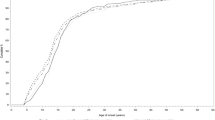Abstract
The objectives of this study were: (1) to examine Composite International Diagnostic Interview (CIDI) period prevalence and comorbidity for depression and anxiety disorder in a cohort of women assessed during the first 6–8 months postpartum and (2) to examine the benefits of combining the Edinburgh Postnatal Depression Scale (EPDS) with a simple “interval symptom” question to optimize screening postpartum. Women aged over 18 (N = 1,549) were assessed during late pregnancy and reviewed at approximately 2, 4, and 6–8 months postpartum using the EPDS and an “interval symptom” question. The latter asked about any depressive symptoms in the interval since the last EPDS. Women who scored >12 on the EPDS and/or positive on the “interval symptom” question were then administered the CIDI. A further 65 randomly selected women that screened negative were also administered the CIDI. Loss to postnatal follow-up was very significant, and returns rates were inconsistent across the three postnatal time points. Almost 25% of those who screened positive did not complete a CIDI. For screen-positive status, a total of 314 (24.4%) of those that returned questionnaires (N = 1,289) screened positive at least once across the 6- to 8-month interval. Of these, 79 were lost to follow-up; thus, 235 (74.8%) completed a CIDI. In this group, 34.7% had been positive both on the EPDS and the “interval” question, 15.9% on the EPDS alone, and 49.4% on the “interval” question alone. For the CIDI diagnosis and estimated 6- to 8-month period CIDI prevalence, among those 235 women who screened positive and completed a CIDI, 67.2% met the criteria for a CIDI diagnosis, as did 16.9% of those who screened negative. The breakdown in CIDI diagnoses in the 235 women was 32.8% major depression (± anxiety disorder); 26.4% minor depression alone; and 8.1% with a primary anxiety disorder (approximately half with minor depression). Put another way, 20.4% of these women had an anxiety disorder (approximately two thirds with comorbid depression) and 37.7% of women with a major depressive episode (MDE) had a comorbid anxiety disorder. The estimated 6- to 8-month prevalence rate for a CIDI diagnosis of anxiety or depression (major or minor) was 29.2% (95% CI 26.7%–31.7%). The use of the “interval symptom” question alone was 1.7 times more likely to identify positive CIDI cases than the EPDS alone. Almost 40% of postnatal women with a diagnosis of MDE have a comorbid diagnosis of anxiety disorder. The estimated 6- to 8-month period prevalence for CIDI cases of anxiety and depression was 29.2%. Screening for anxiety and depression using the EPDS alone was associated with a lesser capacity to identify CIDI caseness than a simple “interval symptom” question (for the 2 months prior) which almost doubled the yield. This paper demonstrates that combining the EPDS with the “interval symptom” question improves detection of CIDI caseness.

Similar content being viewed by others
References
American Psychiatric Association (1994) Diagnostic and statistical manual of mental disorders, 4th edn. American Psychiatric Association, Washington
Austin M-P, Hadzi-Pavlovic D, Leader L et al (2005a) Antenatal screening for the prediction of postnatal depression: validation of a psychosocial pregnancy risk questionnaire. Acta Psychiatr Scand 112:310–317
Austin M-P, Hadzi-Pavlovic D, Leader L et al (2005b) Maternal anxiety, depression, cognitive style and life event stress in pregnancy: relationship with infant temperament. Early Human Dev 81:183–190
Cox JL, Holden JM, Sagovsky R (1987) Detection of postnatal depression: development of the 10 item Edinburgh postnatal depression scale. Br J Psychiatry 150:782–786
Eberhard-Gran M, Eskild A, Tambs K et al (2001) Review of validation studies of the Edinburgh postnatal depression scale. Acta Psychiatr Scand 104(4):243–249
Gavin NI, Gaynes BN, Lohr KN, Meltzer-Brody S, Gartlehner G et al (2005) Perinatal depression: a systematic review of prevalence and incidence. Obstet Gyn 106:1071–1083
MaierW GM, Weiffenbach O (1997) The relationship between major and subthreshold variants of unipolar depression. J Affect Disord 45:41–51
Matthey S, Barnett B, Howie P et al (2003) Diagnosing postpartum depression in mothers and fathers: whatever happened to anxiety? J Affect Disord 74:139–147
Navarro P, Garcia-Esteve L, Ascaso C et al (2008) Non-psychotic psychiatric disorders after childbirth: prevalence and comorbidity in a community sample. J Affect Disord 109:171–176
Preisig M, Merikangas KR, Angst J (2001) Clinical significance and comorbidity of subthreshold depression and anxiety in the community. Acta Psychiatr Scand 104:96–103
Protopopescu, Reilly N, Barnett B et al. (2008) Screening and assessment in the perinatal period for women experiencing, or at risk of, depression, psychological distress, and dysfunction: a review for the beyondblue Perinatal Mental Health Program. In: beyondblue: the national depression initiative. National Action Plan for Perinatal Mental Health, Full Report, May 2008. Available at http://www.beyondblue.org.au/index.aspx?link_id=4.665&tmp=FileDownload&fid=1057
Reck C, Stehle E, Reinig K et al (2009) Maternity blues as a predictor of DSM-IV depression and anxiety disorders in the first three months postpartum. J Affect Disord 113:77–87
Robins LN, Wing JK, Wittchen H-U et al (1988) The composite international diagnostic interview. Arch Gen Psychiatry 45:1069–1077
Wenzel A, Haugen EN, Jackson LC et al (2005) Anxiety symptoms and disorders at eight weeks postpartum. J Anx Disord 19:295–311
World Health Organization WHO (1997) CIDI—Auto version 2.1. Administrator’s guide. WHO, Sydney
Acknowledgments
We gratefully acknowledge the funding from the National Health and Medical Research Council Program Grant (no. 510135), the Black Dog Institute and infrastructure funding from the NSW Department of Health.
Author information
Authors and Affiliations
Corresponding author
Rights and permissions
About this article
Cite this article
Austin, MP.V., Hadzi-Pavlovic, D., Priest, S.R. et al. Depressive and anxiety disorders in the postpartum period: how prevalent are they and can we improve their detection?. Arch Womens Ment Health 13, 395–401 (2010). https://doi.org/10.1007/s00737-010-0153-7
Received:
Accepted:
Published:
Issue Date:
DOI: https://doi.org/10.1007/s00737-010-0153-7




